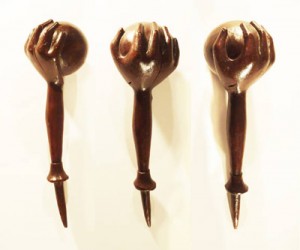Article Origin
Volume
Issue
Year
An early 18th century pre-contact Nuu-chah-nulth artifact that once belonged to explorer Captain James Cook has returned home to the Northwest Coast, thanks to the generosity of a wealthy art collector.
The nearly 300-year-old artifact was purchased by Vancouver art philanthropist Michael Audain last December from a private New York collector. It’s estimated worth is $1.2 million.
Then on March 20th, Audain gave the artifact to the Museum of Anthropology in Vancouver.
The artifact, created by ancestors of the Mowachaht-Muchalaht people currently located near Gold River, B.C. at Tsaxana, is believed to be a fish club fashioned from yew tree wood and carved by using stone and shell tools. The club was given to Cook by the Mowachaht, a member of the larger Nuu-chah-nulth nation, during the explorer’s third voyage to the Friendly Cove area of Nootka Sound in 1778. The club was the last privately-owned First Nation artifact of Cook’s original collection and the first of its kind in Canada.
“This is the only work of its kind that was privately held left in the world,” Audain explained. “No museum in Canada has one of these works specifically from Nootka Sound,” he said.
During his speech at the repatriation ceremony on March 20, Audain told distinguished guests that two of his greatest interests have always been the life and voyages of Captain James Cook and First Nations art of the Northwest Coast.
“It’s a beautiful piece of art,” said Audain. “I obtained the piece because I wanted to put it in a museum here,” he explained.
“It’s great to have a pre-contact piece,” said Anthony Shelton, director at the Museum of Anthropology [MOA] in Vancouver. “It’s a piece that speaks entirely of Aboriginal aesthetic and technology,” he explained.
Shelton said it is important that the piece has found its way home, considering that a vast majority of historic First Nation pieces from the area have not.
“Eighty per cent of Northwest Coast art is on the East Coast or Europe,” noted Shelton.
“There’s not a lot available because so much of the works were collected in the 19th century by European and U.S. museums,” Audain explained.
The artifact will be kept in the permanent collections area in what is known as the ‘Multiversity’ section of the museum.
“It’s acted as a testament and a preserver of that [Nuu-chah-nulth] culture,” Shelton said of the club’s history.
“All First Nations tell me it is a way connecting with their culture and their past,” agreed Audain. “I think it’s very important that young First Nation artists see the work of the great masters of the past,” he said, explaining why he repatriated the piece.
“I thank him,” said Margarita James of Audain’s gift. “ A lot of people wouldn’t have done it. It’s all about giving back,” she said.
James, a member of the Mowachaht/Muchalaht First Nation, represented the community during the repatriation ceremony.
“I was honoured,” she said. “ I thought it was a wonderful experience.”
James said the club represents the generosity of her people and the reclaiming of a proud history nearly destroyed through colonization, potlatch prohibition and residential school tyranny.
“He [Cook] was a visitor to the area and that’s just the way our people are. We host people, we give gifts,” James said proudly.
“This item has meaning to us,” explained James. “It has meaning in that we can learn about ourselves again,” she said.
But if the Nuu-chah-nulth people want to see the artifact they will have to go to Vancouver.
“I chose MOA because I felt the museum was the best place to house the artifact,” Audain said. “My preference would have been to donate it to a museum closer to where it came from in Nuu-chah-nulth territory but unfortunately there are a limited number of museums in First Nation villages,” he explained.
James agreed and said she understands that the artifact must be held at MOA because her community doesn’t have a designated museum or centre to hold the important artifact. However, James said the band has been trying to find a way to built a cultural centre so that someday they will be able to house and display their own history and tell their own story.
“That’s our goal,” said James of a cultural centre built on reserve. “That’s what we want. That’s what we’ve been working toward.”
James said her community created the ‘Land of Maquinna Cultural Society’ in 1995 to encourage the band’s cultural development and regain needed historic knowledge. But due to a lack of funding the volunteer-run society has been unable to build the cultural centre they desperately want.
James said she has made calls on behalf of her band to Aboriginal Affairs Minister John Duncan to lobby for cultural development support to build a centre.
And while the band did received $50,000 from the Residential School Truth and Reconciliation Program coffers, James said those funds have been set aside for the creation of a welcome pole the community plans to raise this summer.
“We need support from the government of Canada,” said James. “They create sports arenas, they should help us with sharing our history with the world and so that our kids can learn about our culture,” she said.
“We want to have these [artifacts] to learn about our history,” James continued. “ We need to learn about who we are.”
To date, Audain has repatriated and donated First Nations artifacts to the Royal BC Museum, the Vancouver Art Gallery and the U’Mista Cultural Centre in Alert Bay. He said he hopes to donate to on-reserve cultural centres in the future.
- 3328 views

